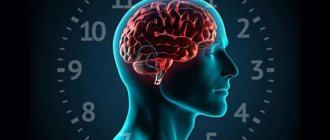Somatoform disorder (somatized mental reaction) is a psychosomatic disorder manifested by various complaints in the absence of objective evidence of the presence of serious diseases.
In psychiatry there is such a thing as a somatized mental reaction. It manifests itself in a person as complaints of distress or pain, but without clinical confirmation. That is, someone may say that their heart hurts or they feel a burning sensation in the stomach. But with careful research, no malfunctions in the functioning of the body are detected. Such phenomena are the result of a psychosomatic disorder. And among psychologists, this refers to a full-fledged mental illness that requires immediate treatment.
Why does somatoform disorder occur?
The main reason for this manifestation is external factors. For example, stress at work or problems in the family, lack of attention from loved ones, burdened financial situation. In some cases, complaints about disorders in the body are a reason to draw attention to yourself. It is noteworthy that people with such a deviation themselves actually feel the symptoms. They are real to them. But they are not caused by physical illnesses, but by the reaction of the nervous system to environmental aggression (stress, problems, emotional stress or exhaustion). At a subconscious level, pain receptors in one or another area of the body are activated. Unfortunately, many people find it difficult to prove that everything is fine with them if the results of tests and examinations are 100% positive.
Somatoform disorder (psychosomatic illness) - symptoms and treatment
Patients with this disorder do not see a connection between psychological experiences and clinical manifestations of the disease. They are fixated on physical (somatic) symptoms and are focused mainly on drug treatment from therapists.
Most often, people with somatoform disorder are bothered by various pains (algias), while painful manifestations are not always symptoms of organ pathology. Such painful sensations caused by mental disorders are encountered quite often. As a rule, they are not relieved even by strong analgesics. This is especially true for psychogenic headaches, which are more common than other headaches combined. The most common headaches are cephalgia (in the area from the eyebrows to the back of the head).
Gastrointestinal disorders, particularly constipation and diarrhea, often occur. From a psychoanalytic point of view, a tendency to constipation may indicate greed, a person’s reluctance to part with something. Diarrhea (we are not talking about a single diarrhea, but about a protracted or frequently recurring problem) can be a reaction to severe fear and severe anxiety. Diarrhea is an “escape” from a problem that cannot be comprehended.
The emotional manifestation of somatoform disorder includes depression. It is associated with self-directed aggression. Physical manifestations mainly include coronary heart disease, surges in blood pressure, and peptic ulcers of the stomach or duodenum. The latter is more often typical for people who do not know how to recognize aggressive emotions in themselves, such as irritation, anger, anger. Trying to prohibit oneself from experiencing them, not knowing how to express them in an “ecological” way, a person destroys himself from the inside.
Suppression of feelings of anxiety and fear, especially when their causes are unclear, cause a cascade of psychophysiological reactions (previously this was called a sympathoadrenal crisis).
In the primitive world, the source of the threat that caused fear was obvious - for example, an encounter with a bear. In this case, there were only two response options - hit or run. In modern society, the threat is not so obvious, and social norms and attitudes impose their own “prohibitions” on the manifestation of reactions. In this regard, panic and horror unfold inside a person, causing a cascade of vegetative reactions - cold sweat breaks out, the heartbeat quickens, blood pressure jumps against the background of the production of stress hormones, breathing becomes shallow and frequent. And here secondary anxiety arises, and with it the fear of loss of control, the onset of a heart attack, stroke and death. Often such patients call an ambulance, are repeatedly examined by therapists, cardiologists, neurologists and endocrinologists, undergo a series of diagnostic and laboratory tests and, not finding the cause of fear in diseases of the internal organs, are referred to a psychotherapist with a diagnosis of “Panic attack”.
Frequent throat diseases (sore throat or tonsillitis) may indicate a person’s fear of saying something or asking for something very important. Sometimes such people are afraid to raise their voice in their own defense and thereby “lose” it.
Bronchial asthma, like some other diseases associated with respiratory failure, occurs more often in people (mainly children) who are pathologically strongly attached to their mother. Their love is literally “suffocating.” Another option is parents’ strictness when raising a son or daughter. If a person is taught from a very early age that it is forbidden to cry, that laughing loudly is indecent, that jumping and running in the street is the height of bad form, then the child grows up afraid to express his true feelings and needs: they gradually begin to “strangle” him from the inside.
Neurodermatitis, psoriasis, atopic dermatitis, urticaria, like most diseases related to allergies, may indicate a rejection of something. The skin is the first protective psychological barrier, so its disease indicates a violation of a person’s psychological boundaries.
How is the treatment carried out?
The basis of the rehabilitation course includes both taking medications and periodic work with a psychiatrist.
Patients are prescribed the following groups of drugs:
— Tranquilizers with sedative effects (for example, phenazepam); — Antidepressants that improve emotional state and neutralize the state of apathy; - Neuroleptics (for example, Sonapax), which block the feeling of panic and anxiety; - Beta blockers (for example, propranolol), which neutralize trembling, sweating and other manifestations of autonomic manifestations.
Diagnosis of somatoform disorder
The disease may remain undiagnosed for a long time due to the variety of symptoms, especially with somatization and undifferentiated somatoform disorders. The basis for the diagnosis of somatoform disorders is the collection of anamnesis and analysis of behavioral reactions. The presence of a disorder may be indicated by an improvement in condition after diagnostic examinations, ineffectiveness of treatment for a suspected somatic disease, uncertainty of complaints, or their dramatic change over time. The disorder may be accompanied by somatic illnesses, anxiety and depressive disorders.
It is important to pay attention to the presence of these clinical manifestations:
- Specific emotionally charged complaints about somatic malaise, autonomic dysfunctions, functional disorders (pain, cramps, muscle tremors, sleep disorders, appetite disorders, etc.) A person is fixated on any confirmation of his “diagnosis” and requires the appointment of examinations.
- The presence of manifestations of a mental disorder of the neurotic range (anxiety, fussiness, mood swings, irritability, short temper, apathy, fatigue, etc.)
- The presence of disorders of the somatosensory system. Sensopathy often manifests itself in the form of paresthesia (sensations of burning, burning, drilling, tingling, etc.). With paresthesia, the patient clearly points to the organ that is bothering him, describes the sensations clearly and emotionally. If discomfort is interpreted by the patient as pain, this is senestalgia. Senestalgia is distinguished by the location of pain and has its own name. With senestopathy, it is difficult for a person to describe what he feels; as a rule, the discomfort does not have a clear localization.
In the presence of pronounced somatic symptoms for two or more years, with social maladjustment and a persistent change in the emotional background, a diagnosis of somatization disorder is possible. If the disease lasts for at least six months and the clinical picture is atypical, an undifferentiated somatoform disorder is diagnosed. If a person experiences persistent anxiety about his health and fear of the “incurability of the disease,” a diagnosis of hypochondriacal disorder is made.
Differential diagnosis is carried out with the initial stages of somatic diseases, depression, hypochondriacal delirium and other mental disorders.
Causes of hypochondria
Hypochondriacal disorder can be an independent disease, but it is often included in a complex of other mental disorders. Hypochondria can be a component of a depressive disorder, and, in this case, a negative psycho-emotional background, experiences and disorders actually lead to deterioration of health.
Currently, the following predisposing factors are identified:
- a certain personality structure (first of all) – a tendency to pay increased attention to one’s body and its functions: such people are accustomed to “listening” to what is happening to them, how they feel;
- heredity - if a child has at least one parent who is hypochondriacal, then there is a high probability that he will develop the same disorder in the future;
- incorrect perception of the stimuli of the internal organs, which are perceived as symptoms of a “terrible” disease, for example, “rumbling” in the stomach begins, which is caused by the normal movement of gases through the intestines, and the patient sees this as signs of intestinal obstruction;
- imitation of others - we are talking about a child who sees a sick person next to him and notices increased attention to him: he invents a disease for himself in order to also be in the center of attention.
Particular attention should be paid to actual somatic diseases - if they occur in a severe form, then a person may develop fear, which is a provoking factor for the development of hypochondria in the future. Most often, hypochondriacal disorder is associated with difficult life situations and conflicts, but the patient himself denies such a relationship.
HYPOCHONDRICAL DISORDER
Hypochondria is a person's unreasonable concern about his health, which is accompanied by obsessive thoughts about the presence of a serious or incurable illness. Hypochondria is a mental disorder, a symptom of a mental disorder, or a personality trait.
CAUSES OF APPEARANCE The exact cause of the formation of this symptom is not known. According to physiologists, the appearance of hypochondriacal thoughts can be caused by the following processes: Impaired coherence in the work of the cerebral cortex Distorted perception by the cerebral cortex of impulses from internal organs Disruption between the work of the autonomic nervous system and the cerebral cortex The first manifestation of delusional disorders
SYMPTOMS OF HYPOCHONDRIA DISORDER Patients with hypochondria vividly and emotionally describe the signs of certain serious diseases (cancer, HIV, severe diseases of the internal organs), but upon examination there are no signs of the disease. They constantly listen to the processes occurring in the body. Realizing that their experiences are excessive, patients with hypochondria cannot get rid of obsessive depressing thoughts. Hypochondria can develop under the influence of external provoking factors (rash words from a doctor; viewing medical advertisements, for example, by medical students studying the symptoms of diseases). The development of obsessive hypochondria is promoted by an anxious-suspicious personality type.
DIAGNOSTICS Diagnosis begins with standard studies, which include blood, urine, stool, ultrasound of internal organs, etc. If no pathology in the internal organs is detected, and concerns about the state of health persist, the patient is recommended to consult a psychiatrist or psychotherapist.
TYPES OF DISEASE There are overvalued and delusional hypochondria. With extreme hypochondria, patients react very sharply to even mild health problems, adhere to self-invented diets, and take a lot of medications, vitamins and dietary supplements (dietary supplements). These people often believe that they are being treated incorrectly and sue clinics and doctors. This type of hypochondria can be observed during exacerbation of psychopathy or the onset of schizophrenia. Patients with delusional hypochondria are confident that they have incurable diseases. They interpret the doctor’s attempts to dissuade them as hopelessness of the condition (allegedly medicine is powerless against their illness). Delusions, hallucinations, and depression are possible. Suicide attempts are common.
ACTIONS OF THE PATIENT If you or your loved ones have obsessive, anxious thoughts about their health for no apparent reason, you need to consult a therapist. The doctor will determine whether there is cause for concern about your physical health or whether you have developed hypochondria. Depression and schizophrenia can begin with manifestations of hypochondria. The sooner the patient sees a doctor and begins treatment, the more favorable the prognosis.
TREATMENT OF HYPOCHONDRIA DISORDER The basis of treatment is working with a psychotherapist and psychiatrist, support from family and friends. Correction of disorders in the cerebral cortex is carried out, establishing normal connections between the cortex and the autonomic part of the nervous system. For neurotic disorders accompanied by hypochondria, tranquilizers or antipsychotics are used. For depressive hypochondria, antidepressants are prescribed. Your doctor may approve the use of calming herbal remedies. If hypochondria is a symptom of schizophrenia, antipsychotics are prescribed. Hospital treatment may be needed.
PREVENTION OF HYPOCHONDRIA DISORDER Specific measures for the prevention of hypochondria do not yet exist. However, creating a favorable environment in the family and team, treating a sick person with understanding helps reduce the severity of symptoms. People with an anxious-suspicious personality type should avoid viewing advertisements on medical topics, medical programs and reading websites dedicated to diseases.
3. Treatment of the disease
Patients suffering from somatoform disorders always think that their physical symptoms are caused by a very real illness. They also often don't believe that mental factors can also play an important role in physical health.
A friendly, trusting relationship between doctor and patient is the key to understanding the treatment of somatoform disorders. In addition, meeting with one such doctor will help save a lot of time, nerves and money on unnecessary tests to look for non-existent diseases.
Unlike many other diseases, treatment for somatoform disorders does not focus on symptoms, but on increasing daily activity. Reducing stress also helps treat somatoform disorders.
Cognitive therapy can help relieve symptoms of somatoform disorders. With the help of therapy the following is corrected:
- Altered vision of reality;
- Unrealistic expectations;
- Behavioral factors.
About our clinic Chistye Prudy metro station Medintercom page!









